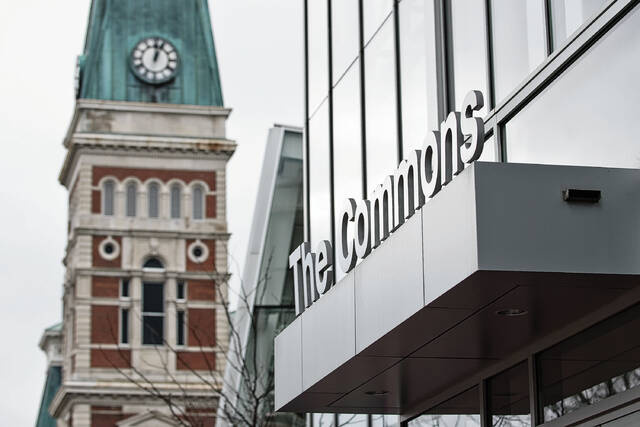
Pictured: The exterior of The Commons with the Bartholomew County Courthouse pictured in the background Jan. 24, 2017, in downtown Columbus. Mike Wolanin | The Republic
Bartholomew County government has accumulated one of the largest piles of cash reserves in its history.
With a transfer of $4.23 million from the county’s general fund into the so-called Rainy Day Fund, Bartholomew County’s reserve account is now more than $10.22 million. The transfer was unanimously approved with little discussion by the Bartholomew County Council during a regular meeting this month.
During questioning, Republican District 1 county council candidate Dave London asked whether the transfer included any federal funds from the American Rescue Plan (ARP). Two council members immediately replied “No.”
Last May, the county received about $8 million in ARP funds, while an additional $8.2 million for COVID-19 relief is expected late this spring.
This month’s $4.23 million transfer represents 15% of the 2021 total budget, Bartholomew County Auditor Pia O’Connor said.
“Since I took office in January of 2019, the council has transferred available funds to the Rainy Day fund in accordance with state law,” she said.
For almost a year, Bartholomew County government has relied on Baker Tilly US, LLP – a public accounting and consulting firm – to ensure that all spending of ARP funds meet legal guidelines, she said.
County commissioner Larry Kleinhenz said if the federal money isn’t spent according to established criteria, the county would be opening itself up to substantial penalties that might include giving the money back.
Maintaining a healthy financial reserve became a larger priority among council members after the self-insured county saw its cash reserves reduced by high health care costs to about $2 million in 2014.
A key reason why this month’s transaction was so large was because a transfer was not made in 2020 due to the uncertainty of the COVID-19 crisis at that time, O’Connor said.
The concept of transferring large sums of money into the county’s reserve fund was approved years before the pandemic began to spread globally in 2000, council member Mark Gorbett said.
“We have a five-year plan to build these funds up,” Gorbett said. “That’s what we have been doing, so we are not in the same shape we were (in 2014).”
Gorbett compared this type of financial transfer with moving money from checking into savings at a bank.
In the past seven years, there has only been one withdrawal ($41,667) from the Rainy Day fund, which has allowed the reserve fund to maintain a high balance.
Another reason for the excess funds for the county is that county coffers received an additional $1,355,021 in increased property tax revenue last year. It was due, in part, by a 4.3% increase in the growth quotient, a formula used to calculate the annual growth in tax levies.
When the amount of the transfer was revealed, Dave London asked the council to help Bartholomew County residents struggling with inflation by establishing a income tax holiday.
But the county’s acceptance of the federal ARP funds prohibits county government from lowering taxes – even if they don’t use the ARP funds in the process, O’Connor said.
Another suggestion is that the county set aside at least $2 million to make larger payments to pay off most of the $25 million jail renovation bond sooner than expected.
But that effort appeared to lose steam when elected county officials learned they could be assessed a financial penalty for paying off the bond earlier than expected, O’Connor said.
Pia O’Connor
Mark Gorbett
Dave London







